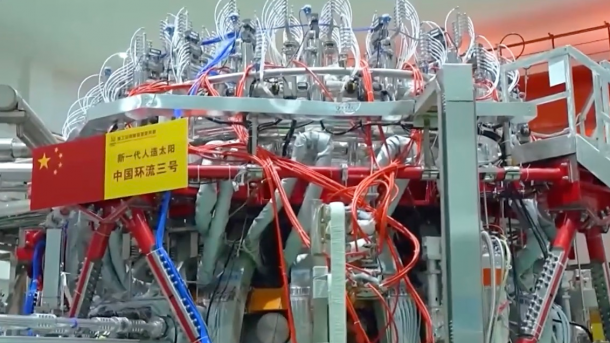Chinese media report breakthrough in nuclear fusion control, details unclear
The China National Nuclear Corporation claims a breakthrough in fusion control in the "artificial sun" project HL-3 but provides no details.

Exterior view of the Huanliu-3 (HL-3) tokamak reactor developed in China
(Image: CNNC)
As various Chinese news media report, the state-owned company China National Nuclear Corporation (CNNC) has succeeded for the first time in discovering and realizing an "advanced magnetic field structure" in the Huanliu-3 (HL-3) fusion research reactor. According to the reports, this should significantly improve HL-3's ability to control the operation of nuclear fusion plants. However, CNNC's nuclear authority does not provide details on what exactly the progress consists of and how it was achieved. The breakthrough is not even mentioned on the company's website.
HL-3 is a large-scale research facility developed by China for controlled nuclear fusion. It is referred to as an "artificial sun", as controlled nuclear fusion generates energy according to the same principle as the natural processes in the sun. Since the end of 2023, HL-3 has been open to the international community for joint research. The first round of joint international experiments involved 17 research institutes and universities, including the French Alternative Energies and Nuclear Energy Authority (CEA) and Kyoto University in Japan.
China also involved in the ITER project
Alongside the European Union, the USA, Russia, India, Japan and South Korea, China is also involved in the construction of the International Thermonuclear Experimental Reactor (ITER) in Cadarache, France. The knowledge gained from HL-3 could also be incorporated into this major international project. As an experimental reactor, ITER is intended to demonstrate the technical and scientific feasibility of generating energy through nuclear fusion. The test operation of ITER is planned for 2025. China itself is aiming to build an industrial prototype by 2035 at the latest and to utilize nuclear fusion energy by the middle of the century as part of its long-term development goals for the nuclear energy industry.
Further progress in fusion research
In January, a Chinese research team from the HL-3 tokamak reported that they had achieved so-called high-confinement operation (H-mode) with a plasma current of one mega ampere (MA) for the first time. This mode improves the performance of the confined plasma and is considered a milestone on the way to the ignition phase.
In nuclear fusion – especially in tokamak reactors – "high-confinement mode" (H-mode) refers to an operating state in which the plasma has an increased energy confinement capacity. In H-mode, a so-called transport barrier forms at the edge of the plasma, which reduces the energy loss. This leads to higher temperatures and densities in the plasma and improves the conditions for fusion reactions.
An important feature of the H-mode is the appearance of a layer with a high-pressure gradient, known as the "edge transport barrier" (ETB). This barrier reduces the radial loss of energy and particles, resulting in a denser and hotter plasma inside the tokamak.
In H-mode, so-called "Edge-Localized Modes" (ELMs) can occur – periodic instabilities that can lead to sudden energy losses. These ELMs must be controlled to ensure stable operation of the fusion reactor.
Other fusion experiments have also recently achieved success: for example, a team from the US defense and nuclear corporation General Atomics succeeded in achieving a plasma density at the DIII-D tokamak for 2.2 seconds that was 20 percent above the limit previously considered possible. At the same time, according to their information, they improved the ability to trap energy in the plasma by 50 percent.
The South Korean research reactor KSTAR also achieved ion temperatures of 100 million degrees Celsius for 48 seconds. The plasma was stable for over 100 seconds. The aim is to maintain the plasma at over 100 million degrees for up to 300 seconds.
(vza)